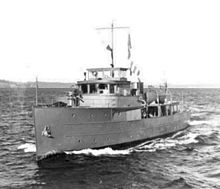
HMS Triton was a submarine of the Royal Navy named for the son of Poseidon and Amphitrite, the personification of the roaring waters. She was the lead ship of the T class of diesel-electric submarines. Her keel was laid down on 28 August 1936 by Vickers Armstrong at Barrow-in-Furness. She was launched on 5 October 1937, and commissioned on 9 November 1938.
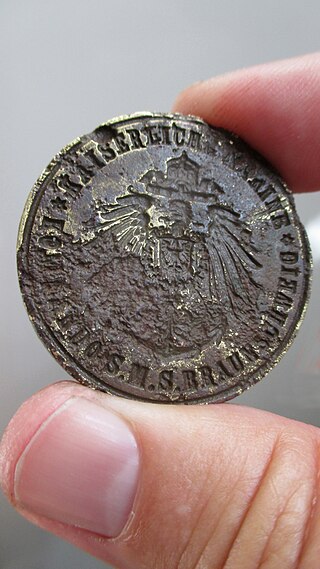
HisMajesty's Ship, abbreviated HMS and H.M.S., is the ship prefix used for ships of the navy in some monarchies. Derivative terms such as HMAS and equivalents in other languages such as SMS are used.

A seaplane tender is a boat or ship that supports the operation of seaplanes. Some of these vessels, known as seaplane carriers, could not only carry seaplanes but also provided all the facilities needed for their operation; these ships are regarded by some as the first aircraft carriers and appeared just before the First World War.

A light aircraft carrier, or light fleet carrier, is an aircraft carrier smaller than the standard carriers of a navy. The precise definition of the type varies by country; light carriers typically have a complement of aircraft only one-half to two-thirds the size of a full-sized fleet carrier. A light carrier was similar in concept to an escort carrier in most respects, however light carriers were intended for higher speeds to be deployed alongside fleet carriers, while escort carriers usually defended equally slow convoys and provided air support during amphibious operations.

The British Pacific Fleet (BPF) was a Royal Navy formation that saw action against Japan during the Second World War. It was formed from aircraft carriers, other surface warships, submarines and supply vessels of the RN and British Commonwealth navies in November 1944.
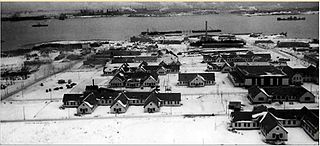
Royal Canadian Navy base HMCS Protector, also known as the Point Edward Naval Base, was located next to Sydney Harbour, on Nova Scotia's Cape Breton Island. It was founded in 1940 and used by the navy during the Second World War. It was mainly used to provision, protect and repair the various merchant marine convoys to Quebec, Halifax, and the United Kingdom. It was a main combat zone during the Battle of the St. Lawrence and the more general Battle of the Atlantic. It continued to be utilized during the Cold War's early stages. It was decommissioned in 1964 and became the initial facility to house the Canadian Coast Guard College that same year. Currently, the Sydport Industrial Park utilizes the base's former piers and land.
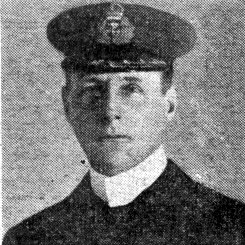
Henry Peel Ritchie VC was a recipient of the Victoria Cross, the highest and most prestigious award for valour "in the face of the enemy" that can be given to members of the British and Commonwealth armed forces. Ritchie received the first VC awarded to naval personnel during the First World War for his actions during a raid on the German colonial harbour of Dar-es-Salaam in November 1914, which left him seriously wounded.

From 31 May to 8 June 1942, during World War II, Imperial Japanese Navy submarines made a series of attacks on the Australian cities of Sydney and Newcastle. On the night of 31 May – 1 June, three Ko-hyoteki-class midget submarines, each with a two-member crew, entered Sydney Harbour, avoided the partially constructed Sydney Harbour anti-submarine boom net, and attempted to sink Allied warships. Two of the midget submarines were detected and attacked before they could engage any Allied vessels. The crew of M-14 scuttled their submarine, whilst M-21 was successfully attacked and sunk. The crew of M-21 killed themselves. These submarines were later recovered by the Allies. The third submarine attempted to torpedo the heavy cruiser USS Chicago, but instead sank the converted ferry HMAS Kuttabul, killing 21 sailors. This midget submarine's fate was unknown until 2006, when amateur scuba divers discovered the wreck off Sydney's northern beaches.
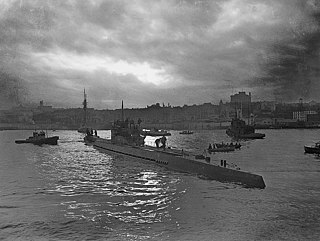
The Battle of the St. Lawrence involved marine and anti-submarine actions throughout the lower St. Lawrence River and the entire Gulf of Saint Lawrence, Strait of Belle Isle, Anticosti Island and Cabot Strait from May–October 1942, September 1943, and again in October–November 1944. During this time, German U-boats sank over 20 merchant ships and four Canadian warships. There were several near-shore actions involving the drop of German spies, or the attempted pickup of escaping prisoners of war. Despite the 23 ships lost, this battle marked a strategic victory for Canadian forces as ultimately they managed to disrupt U-boat activity, protect Canadian and Allied convoys, and intercept all attempted shore operations. This marked the first time that a foreign power had inflicted casualties in Canadian inland waters since the US incursions in the War of 1812.

A landing ship, infantry (LSI) or infantry landing ship was one of a number of types of British Commonwealth vessels used to transport landing craft and troops engaged in amphibious warfare during the Second World War. LSIs were operated by the Royal Navy, British Merchant Navy, Royal Canadian Navy, Royal Indian Navy, and Royal Australian Navy. They transported British Commonwealth and other Allied troops in sea assaults and invasions throughout the war.

HMCS Sioux was a V-class destroyer of the Royal Canadian Navy which fought in the Second World War and the Korean War. She was launched as HMS Vixen for the British Royal Navy before being transferred to the Royal Canadian Navy. She was then named for the Sioux people of Canada's western provinces.
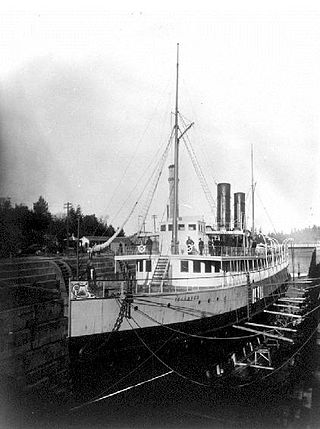
Esquimalt Royal Naval Dockyard was a major British Royal Navy yard on Canada's Pacific coast from 1842 to 1905, subsequently operated by the Canadian government as HMC Dockyard Esquimalt, now part of CFB Esquimalt, to the present day.

The QF 4 inch Mk XVI gun was the standard British Commonwealth naval anti-aircraft and dual-purpose gun of World War II.

The Raid on Saint-Paul was an amphibious operation conducted by a combined British Army, Royal Navy and Royal Marines force against the fortified French port of Saint Paul on Île Bonaparte during the Napoleonic Wars. The operation was launched on 20 September 1809 as both a precursor to a future full-scale invasion of Île Bonaparte and in order to capture the French frigate Caroline and the East Indiamen she had seized in the action of 31 May 1809 which were sheltering in the harbour. The operation was a complete success, with British storming parties capturing the batteries overlooking the port, which allowed a naval squadron under Commodore Josias Rowley to enter the bay and capture the shipping in the harbour.

The Java campaign of 1806–1807 was a minor campaign during the Napoleonic Wars by British Royal Navy forces against a naval squadron of the Kingdom of Holland, a client state of the French Empire, based on the island of Java in the Dutch East Indies. Seeking to eliminate any threat to valuable British merchant convoys passing through the Malacca Straits, Rear-Admiral Sir Edward Pellew determined in early 1806 that the Dutch naval forces based at Java, which included several ships of the line and three frigates, had to be defeated to ensure British dominance in the region. Lacking the forces to effect an invasion of the Dutch colony, Pellew instead sought to isolate and blockade the Dutch squadron based at Batavia in preparation for raids specifically targeting the Dutch ships with his main force.
The Raid on Griessie was a British attack on the Dutch port of Griessie on Java in the Dutch East Indies in December 1807 during the Napoleonic Wars. The raid was the final action in a series of engagements fought by the British squadron based in the Indian Ocean against the Dutch naval forces in Java. It completed the destruction of the Dutch squadron with the scuttling of three ships of the line, the last Dutch warships in the region. The British squadron—under the command of Rear-Admiral Sir Edward Pellew—sought to eliminate the Dutch to safeguard the trade route with China, which ran through the Straits of Malacca and were in the range of Dutch raiders operating from the principal Javan port of Batavia. In the summer of 1806, British frigates reconnoitred Javan waters and captured two Dutch frigates, encouraging Pellew to lead a major attack on Batavia that destroyed the last Dutch frigate and several smaller warships. Before the Batavia raid, however, Dutch Rear-Admiral Hartsinck had ordered his ships of the line to sail eastwards, where they took shelter at Griessie, near Sourabaya.

Adele was a steel screw steamer that was built in 1906 as a yacht. She was twice commissioned into the Royal Australian Navy (RAN), firstly as HMAS Franklin and later as HMAS Adele. She was wrecked at Port Kembla, New South Wales on 7 May 1943.

The Battle of Jean-Rabel consisted of two connected minor naval engagements of the French Revolutionary Wars and the Haitian Revolution. The first engagement saw an overwhelming British Royal Navy force consisting of two ships of the line attack and destroy a French Navy frigate in Moustique Inlet near the town of Jean-Rabel on the Northern coast of the French colony of Saint-Domingue. The second engagement took place four days later when a force of boats launched from a British frigate squadron attacked the town of Jean-Rabel itself, capturing a large number of merchant ships in the harbour that had been seized by French privateers.
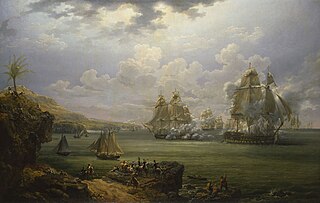
The blockade of Saint-Domingue was a naval campaign fought during the first months of the Napoleonic Wars in which a series of British Royal Navy squadrons blockaded the French-held ports of Cap-Français and Môle-Saint-Nicolas on the northern coast of the French colony of Saint-Domingue, soon to become Haiti, after the conclusion of the Haitian Revolution on 1 January 1804. In the summer of 1803, when war broke out between the United Kingdom and the French Consulate, Saint-Domingue had been almost completely overrun by Haitian Armée Indigène troops led by Jean-Jacques Dessalines. In the north of the country, the French forces were isolated in the two large ports of Cap-Français and Môle-Saint-Nicolas and a few smaller settlements, all supplied by a French naval force based primarily at Cap-Français.

HMS Castle Harbour was a civilian harbour vessel of 730 tons that was taken-up from trade (TUFT) during the Second World War by the Royal Naval Dockyard in Bermuda for use by the Royal Naval Examination Service and later armed and commissioned as a warship, providing harbour defence from submarines.

